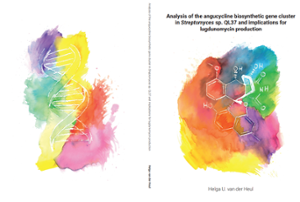Dissertation
Analysis of the angucycline biosynthetic gene cluster in Streptomyces sp. QL37 and implications for lugdunomycin production
Streptomyces bacteria are a valuable source of natural products, many of which are used in the clinic or in biotechnology.
- Author
- Heul, H.U. van der
- Date
- 21 December 2022

In our search for novel antibiotics we discovered lugdunomycin, a natural product with a highly complex chemical architecture that is produced by Streptomyces sp. QL37. It is derived from the angucyclines, a well-known class of molecules known for their antibacterial and anticancer activities. Though angucyclines are produced in high quantities under most conditions, lugdunomycin is produced in minimal amounts. This thesis describes novel insights into the transcriptional control of the lugdunomycin biosynthetic gene cluster and into the lugdunomycin biosynthesis pathway. These insights may be applied to improve the yield of lugdunomycin and expand the chemical diversity of angucyclines. Using molecular biology, bioinformatic approaches and omics studies, such as metabolomics and transcriptomics, we have characterized the lugdunomycin biosynthetic gene cluster, the regulatory genes (lugRI–lugRV) required for transcriptional activation of the cluster, and the oxygenase genes (lugOI–lugOV) that play a key role in the different chemical rearrangements of the angucyclines. Furthermore, this thesis contains a detailed review of the regulatory network that controls antibiotic production in Actinobacteria.
